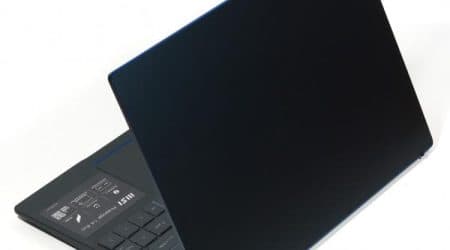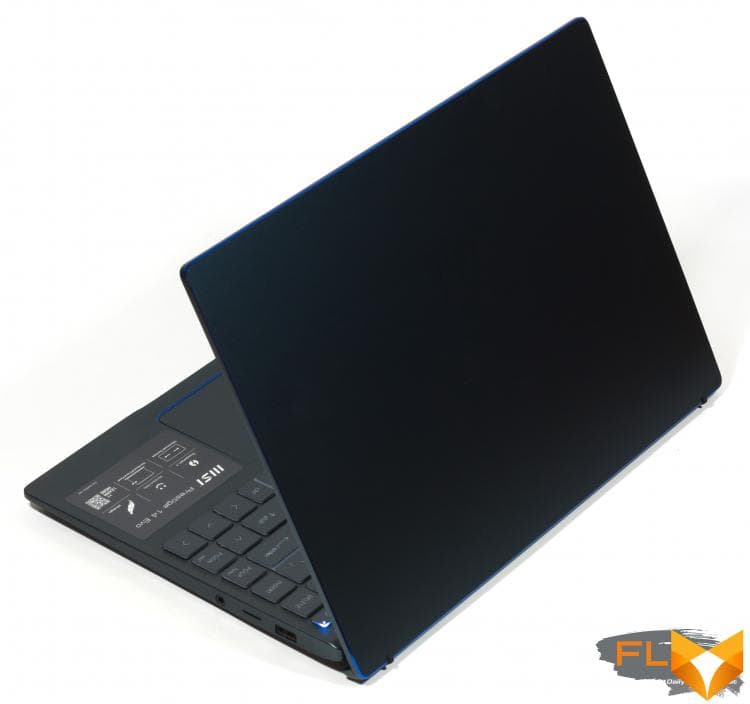


Compact laptops based on 11th generation Intel processors are not new. All major manufacturers that used to use transitional chips with Comet Lake or Ice Lake core have rushed to release updated configurations of their products. And for good reason, because thanks to the Tiger Lake architecture, Intel silicon has made a major leap forward in speed and energy efficiency. Among ultrabooks, an alternative to models based on the deservedly popular AMD Ryzen 4000 series processors has finally appeared.
However, the advantages of Tiger Lake chips are not limited to performance. First, they allowed the use of fourth-generation PCI Express SSDs in mobile PCs. Neither the Ryzen 4000, nor even the fresh 5000 series, provide such an opportunity. Secondly, if Thunderbolt connectors are needed, there are still no other options than the Intel platform (with the exception of the Apple M1-based MacBook). Tiger Lake contains a Thunderbolt 4 controller integrated right into the SoC die, while at the same time offering compatibility with the latest USB standard 4. The creators of budget ultrabooks are forced to neglect these features, but MSI took advantage of all of them, not to mention the aggressive auto-overclocking of the CPU, which also distinguished many previous devices from this manufacturer.

⇡#Specifications, prices
MSI Prestige 14 Evo is far from the first ultrabook based on 11th generation Intel processors, but definitely the most powerful. Instead of the popular Core i7-1165G7 model, the manufacturer equips the top configurations of the laptop with the Core i7-1185G7 chip. Under conditions of maximum power reserve, according to Intel specifications, this processor develops clock speeds 100-200 MHz higher than the Core i7-1165G7. The cheaper option includes the Core i5-1135G7 chip, which runs at lower clock speeds and, importantly, is cut down in the composition of the integrated GPU computing units. Still, there is no discrete graphics processor in the Prestige 14 Evo. Be that as it may, we are already used to the fact that MSI can squeeze the maximum performance out of the hardware of its own ultrabooks, and we expect high achievements in benchmarks from the new product.
Regardless of the model of the central processor, the laptop is always equipped with 16 GB of RAM, but these are LPDDR4X chips, which imposes certain restrictions. First, this type of RAM does not exist in the form of SO-DIMM modules and, accordingly, does not allow user upgrades. Secondly, despite the high clock speeds of LPDDR4X, the resulting bandwidth is lower compared to conventional DDR4 memory due to the twice narrower bus connecting RAM to the processor. We will see that in some tasks, choosing LPDDR4X really limits the potential of the Core i7-1185G7 chip, while in others, on the contrary, high CPU clock speeds and a large power reserve are crucial.
As for the ROM, inside the Prestige 14 Evo there is a rather rare, but promising SSD on a Phison controller (because it is rare because laptops have not yet had PCI Express 4.0 buses) with a capacity of 512 or 1024 GB.
| Manufacturer | MSI |
|---|---|
| Model | Prestige 14Evo A11M-266RU |
| Display | 14”, 1920 × 1080 (60Hz), IPS |
| CPU | Intel Core i7-1185G7 (4/8 cores/threads, 3.0-4.8GHz) |
| RAM | LPDDR4X SDRAM, 4266 MT/s, 16 GB (two channels) |
| GPU | Intel Iris Xe Graphics G7 (1 GB from system memory) |
| Drive | SSD (PCIe 3.0 x4) 1024 GB |
| External I/O connectors | 2 × USB4 Type-C (Thunderbolt 4); 1 x USB 2.0 Type-A; 1x microSD; 1 x TRS 3.5mm |
| Network | IEEE 802.11ax; Bluetooth 5.1 |
| Battery capacity, Wh | 52 |
| Weight, kg | 1.29 |
| Overall dimensions (L × H × D), mm | 319 × 219 × 15.9 |
| Retail price | From $1700 |
The word Evo in the name of the laptop refers to the Intel Evo program, which is a set of performance requirements for a mobile computer. In particular, it must have an 11th generation Core i5 or i7 processor, at least 8 GB of RAM and 256 GB of solid state storage. Nothing extraordinary by the standards of modern ultrabooks, but in order to get the Intel Evo badge, the laptop must also have a dual microphone and high-quality speakers, work on a single battery charge for at least 9 hours, and most importantly, support the Thunderbolt 4 interface and, accordingly, USB4. The MSI Prestige 14 Evo has two such ports at once, as well as USB 2.0 with a Type-A socket. It turns out that you can connect the highest-speed peripherals to the Prestige 14 Evo, but only directly to the Type-C connectors or through an adapter, and Type-A is useless for this. But many MSI laptops still have a microSD card reader, and the Prestige 14 Evo is no exception.
The Prestige 14 Evo’s screen is based on a 1920 x 1080 matrix, but that’s enough for a working machine, and panels with a higher pixel density eat up battery capacity faster.
Despite the impressive specifications, the new MSI turned out to be relatively inexpensive: we found it in retail at a price of $ 1,700 – just behind the older configuration with a Core i7-1185G7 processor and 1 TB of ROM, which will represent the Prestige 14 Evo in performance tests.
⇡#Look and Ergonomics
The Prestige 14 Evo is made in the usual style of MSI laptops and, of course, most of all resembles the previous model Prestige 14, which we tested earlier. However, the layout of the ports and the keyboard shows that the Evo version is assembled in a completely new case. What remains the same is the light weight of the device. Due to the fact that the Prestige 14 Evo does not have a discrete GPU (and probably for some other reason), it was possible to save an additional 90 g, and as a result, the laptop weighs only 1.2 kg, which makes it one of the lightest machines in the world. your class.
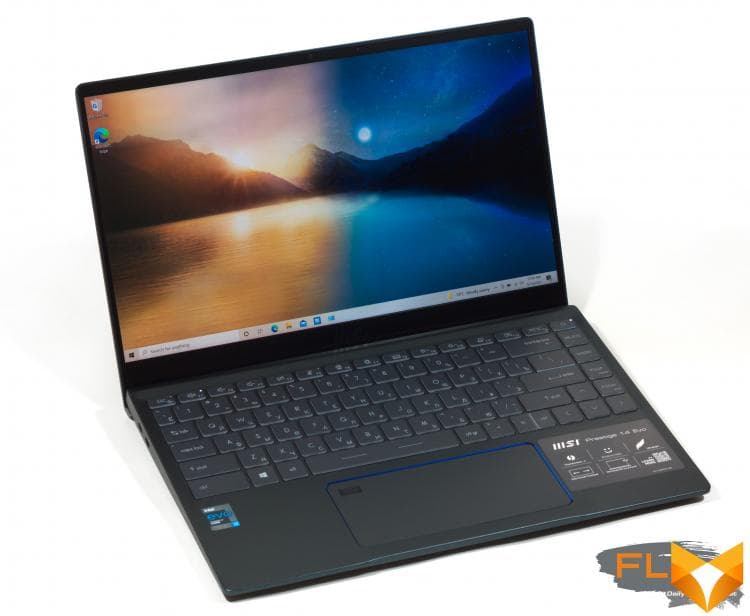
Slim bezels keep the Prestige 14 space-saving in your backpack, and the offset hinge allows you to open the lid 180°. But here is the amendment that the MSI designers made: the coat of arms with a dragon disappeared from the cover, which is not entirely appropriate in the guise of a business computer.
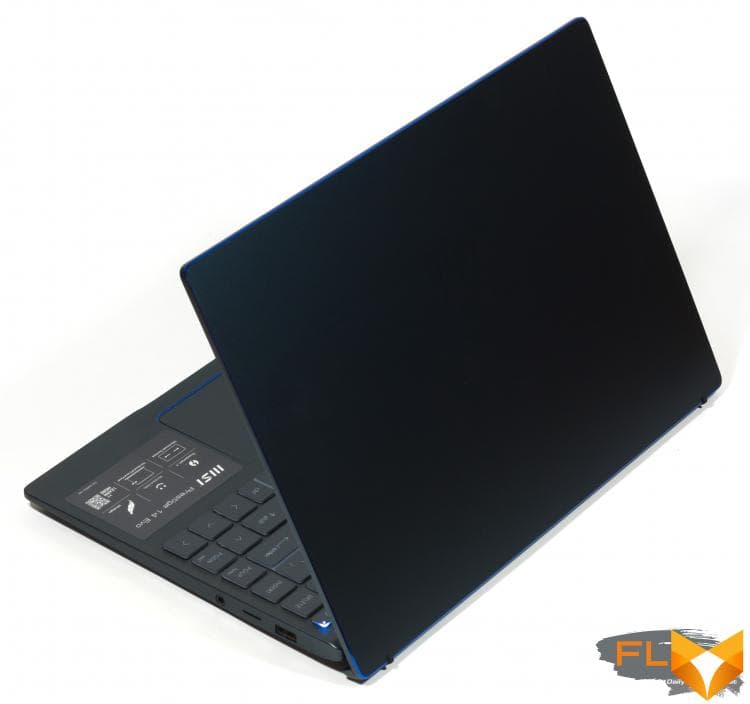
The keyboard that used to be installed in MSI ultrabooks with a screen of 14-15 inches is also a thing of the past. The new one turned out to be better in some ways, and worse in some ways than the old one. The key mechanism still doesn’t give the same crisp response as the best laptop keyboards, but progress has been made in this regard. The keyboard is located in the hollow of the topcase, and therefore the keys have a relatively long travel. And most importantly, their covers are larger than most other laptops. The backlighting is designed so that not only the symbols shine, but also the rim of each key.
In order not to leave unused space on the sides of the keyboard, a number of additional keys were squeezed in on the right: Del, Ins, PgUp and PgDn. However, the new layout is not perfect. By increasing the left Ctrl, MSI has combined the right one with the Fn key, and when two keys bisect one niche, this is always inconvenient. Yes, and the “~” key is still twice as narrow as neighboring ones. And most importantly, the desire to lighten the body of the Prestige 14 Evo affects the strength of the base under the keyboard: during typing, it flexes noticeably, blurring the tactile response.
The laptop’s touchpad lacks size in depth (a typical expense of 16:9 laptops in narrow bezels), but it is very wide. The panel is covered with glass, it is pressed with a confident click and does not emit any extraneous sounds in response to a light press. A biometric sensor is integrated into the upper left corner of the touchpad.
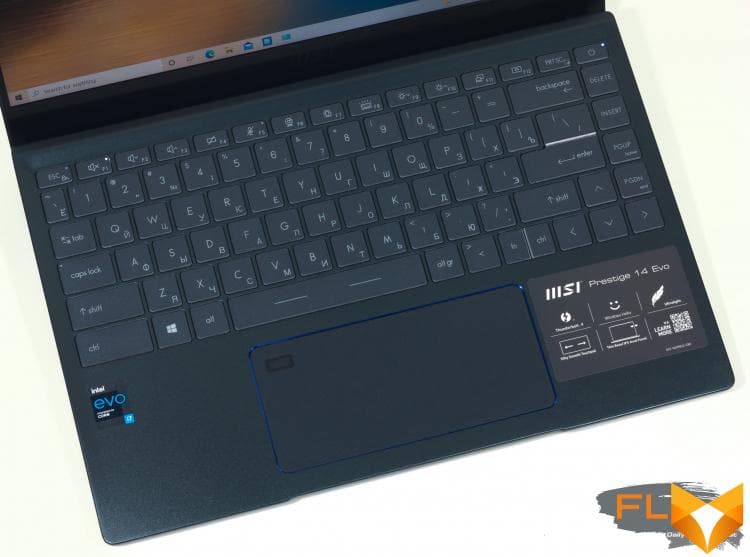
The main means for connecting peripherals to the Prestige 14 Evo are two USB Type-C connectors that pass the signal of the fourth version of the interface of the same name, Thunderbolt 4 or DisplayPort. Any of them can also be used to charge the battery. There is only one Type-A connector, but it is limited by USB 2.0 bandwidth. We are also pleased to note that MSI has retained the microSD card reader.
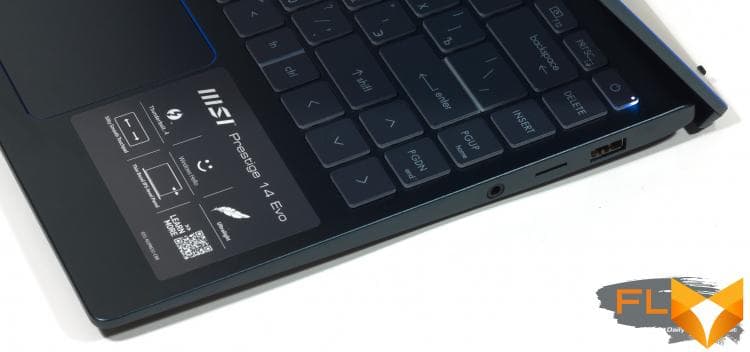
The updated Prestige 14 got a new, more compact 65W power supply, with a short extension cable for a standard three-lobed connector (C5 / C6).
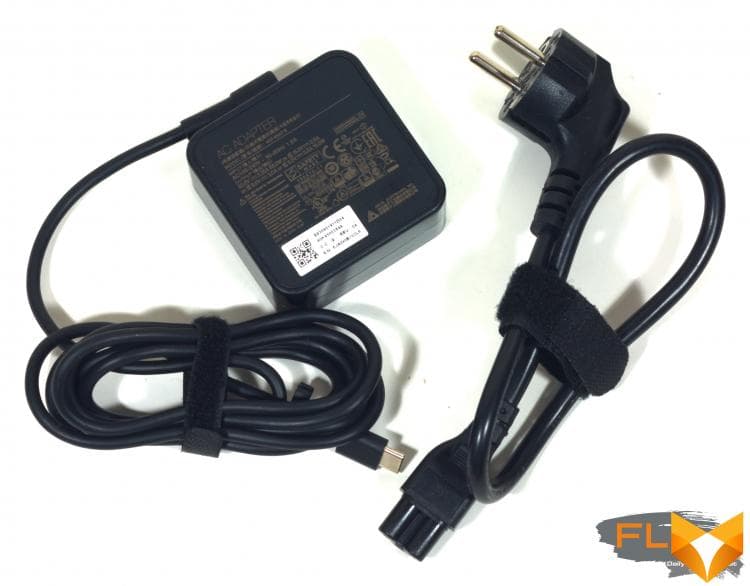
⇡#Internal design and upgrade options
A significant part of the bottom panel of the Prestige 14 Evo is occupied by a ventilation grill, the dimensions of which are concealed by an uneven perforation edge.
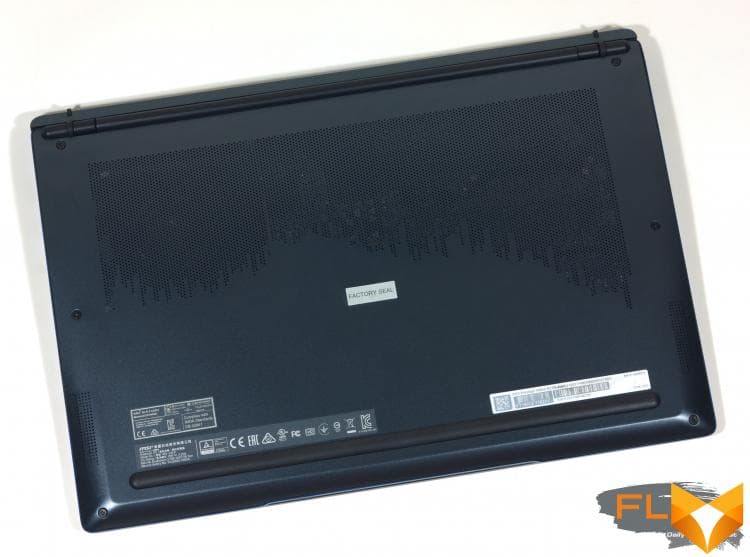
The laptop electronics are assembled on an unexpectedly large motherboard, and it is easy to see why this happened. Next to the CPU, there is an empty layout for a discrete GPU (most likely a GeForce MX450), which MSI can use in other products with Tiger Lake processors.
Due to the high power of the processor (we will soon find out that proprietary software allows you to overclock it up to 30 W), the Prestige 14 Evo needs enhanced cooling. MSI engineers laid two heat pipes between the heat sink and the radiator, but, of course, no modern ultrabook, including the new one, can count on quiet operation in the maximum power consumption mode. However, MSI used almost the same cooler in the previous version of the Prestige 14, and unlike the Prestige 14 Evo, it has a discrete GPU, and quite a powerful one.
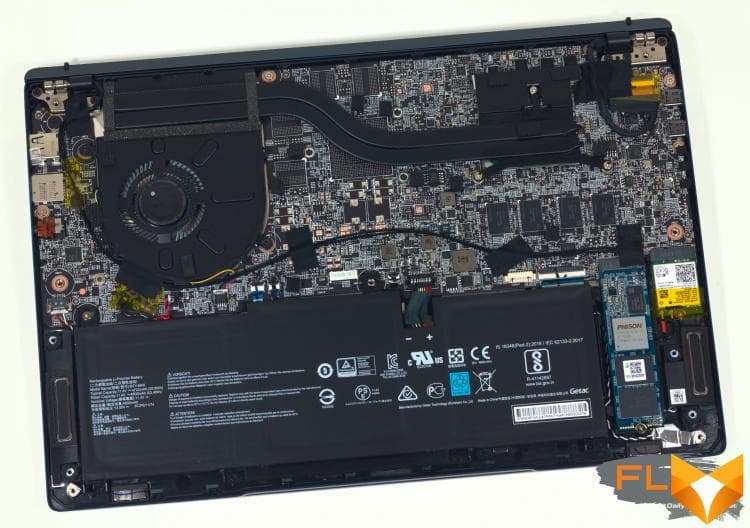
The huge PCB limited the size of other components, in particular the battery here is not as capacious (52 Wh) as some other machines in the Prestige 14 Evo class can boast. The only user-replaceable component here is the SSD. RAM type LPDDR4X does not exist in the form of SO-DIMM modules, so it is always soldered on the motherboard.
⇡#Test Methodology
| Synthetic tests | |
|---|---|
| Application | Settings |
| 3DMark Time Spy | — |
| Geekbench 4 | — |
| CINEBENCH R20 | — |
| GFXBench 5 (Aztec Ruins – Normal Tier, High Tier) | Windows: Vulkan, macOS: Metal |
| fio 3.16 | Sequential Read/Write, Random Read/Write (Unbuffered I/O) |
| Work Applications | |||||
|---|---|---|---|---|---|
| Application | Benchmark | Settings | API | ||
| Intel Graphics | AMD Graphics | NVIDIA Graphics | |||
| Adobe Photoshop CC 2019 | PugetBench for Photoshop CC 0.8 (test structure at link) | Basic Benchmark | OpenGL + OpenCL + Metal (macOS) | OpenGL + OpenCL + Metal (macOS) | OpenGL + OpenCL |
| Adobe Photoshop Lightroom Classic CC 2020 | PugetBench for Lightroom Classic 0.8 (test structure at link) | — | DirectX 12 (Windows) | DirectX 12 (Windows) | DirectX 12 |
| Adobe Premiere Pro CC 2019 | PugetBench for Premiere Pro 0.8 (test structure at link) | Standard Benchmark | OpenCL (Windows)/Metal (macOS) | OpenCL (Windows)/Metal (macOS) | CUDA |
| Blender 2.81a | Class Room Demo from Blender Foundation | Cycles renderer. Feature Set: Supported. Tile size: 32 × 32 (CPU) or 256 × 256 (GPU) | N/A (CPU rendering) | OpenCL | CUDA/OptX |
Display testing is performed using a Datacolor Spyder4 Elite colorimeter in ArgyllCMS and DisplayCAL 3 applications.
Notebook battery life is measured at a display brightness of 200 cd/m2 in the following usage scenarios:
- web surfing: alternately opening and closing tabs of Computeruniverse.ru and Unsplash.com sites with an interval of 25 seconds in the Google Chrome browser (cache and cookies are disabled);
- Continuous playback of 4K HEVC (H.265) video.
⇡#Test participants
The following devices took part in testing:
| Screen | CPU | RAM | GPU | SSD | HDD | Battery | |||
|---|---|---|---|---|---|---|---|---|---|
| MSI Prestige 14 Evo (A11M-266RU) | 14″, 1920 × 1080, IPS | Intel Core i7-1185G7 | 4/8 cores/threads, 3.0-4.8 GHz | LPDDR4X SDRAM, 4266 MT/s, 16 GB | Intel Iris Xe Graphics G7 | 1 GB from system memory | Phison 1TB SM2801T24GKBB4S-E162 (PCIe 4.0 x4) 1024 GB | No | 52 Wh |
| Acer Swift 3 (SF314-57-735H) | 14”, 1920 × 1080, IPS | Intel Core i7-1065G7 | 4/8 cores/threads, 1.3-3.9 GHz | LPDDR4 SDRAM, 2666 MT/s, 16 GB | Intel Iris Plus Graphics G7 | System RAM | Intel SSD 660p (PCIe 3.0 x4) 1024 GB | No | 48.9 Wh |
| Apple MacBook Pro 13″, Late 2020 (A2338) | 13.3”, 2560 × 1600, IPS | Apple M1 | 4+4 cores/threads, ≤3.2 GHz | LPDDR4X SDRAM, 4266 MT/s, 16 GB | 8 iGPU cores | System RAM | Apple AP2048Q (Apple Fabric) 2048 GB | No | 58.2 Wh |
| ASUS ROG Flow X13 (GV301QH-K5228T) | 13.4”, 3840 × 2400, IPS | AMD Ryzen 9 5980HS | 8/16 cores/threads, 3.1-4.8 GHz | LPDDR4X SDRAM, 4266 MT/s, 32 GB | NVIDIA GeForce GTX 1650 Max-Q | 4GB GDDR6 | WD PC SN530 (PCIe 3.0 x4) 1024 GB | No | 62 Wh |
| ASUS ZenBook 14 (UM433IQ) | 14”, 1920 × 1080, IPS | AMD Ryzen 7 4700U | 8/8 cores/threads, 2.0-4.1 GHz | LPDDR4X SDRAM, 4266 MT/s, 16 GB | NVIDIA GeForce MX350 | 2GB GDDR5 | Samsung PM981 (PCIe 3.0 x4) 1024 GB | No | 50 Wh |
| ASUS ZenBook 14 (UX425JA) | 14”, 1920 × 1080, IPS | Intel Core i5-1035G7 | 4/8 cores/threads, 1.2-3.7 GHz | LPDDR4X SDRAM, 3200 MT/s, 16 GB | Intel Iris Plus Graphics G7 | System RAM | Micron 2200 (PCIe 3.0 x4) 1024 GB | No | 67 Wh |
| Dell XPS 13 9300 | 13.4″, 3840 × 2400, IPS | Intel Core i7-1065G7 | 4/8 cores/threads, 1.3-3.9 GHz | LPDDR4X SDRAM, 3733 MT/s, 16 GB | Intel Iris Plus Graphics G7 | System RAM | KIOXIA XG6 (PCIe 3.0 x4) 512 GB | No | 52 Wh |
| HONOR MagicBook 14 (NDR-WFE9HN) | 14″, 1920 × 1080, IPS | Intel Core i7-1165G7 | 4/8 cores/threads, 2.8-4.7 GHz | DDR4 SDRAM, 3200 MT/s, 16 GB | Intel Iris Xe Graphics G7 | 1 GB from system memory | WD PC SN730 (PCIe 3.0 x4) 512 GB | No | 56 Wh |
| HP ProBook x360 435 G7 (1L3L2EA) | 13.3″, 1920×1080, IPS | AMD Ryzen 7 4700U | 8/8 cores/threads, 2.0-4.1 GHz | DDR4 SDRAM, 3200 MT/s, 16 GB | AMD Radeon RX Vega 7 | 512 MB from system RAM | Samsung PM991 (PCIe 3.0 x4) 512 GB | No | 45 Wh |
| HUAWEI MateBook 14 (KLVD-WFE9) | 14″, 2160 × 1440, IPS | Intel Core i7-1165G7 | 4/8 cores/threads, 2.8-4.7 GHz | DDR4 SDRAM, 3200 MT/s, 16 GB | Intel Iris Xe Graphics G7 | 1 GB from system memory | WD PC SN730 (PCIe 3.0 x4) 512 GB | No | 56 Wh |
| Lenovo Yoga Slim 7 (14ARE05) | 14”, 1920 × 1080, IPS | AMD Ryzen 7 4700U | 8/8 cores/threads, 2.0-4.1 GHz | LPDDR4X SDRAM, 4266 MT/s, 16 GB | AMD Radeon RX Vega 7 | 512 MB from system RAM | UMIS RPITJ256VME2MWD (PCIe 3.0 x4) 256 GB | No | 60 Wh |
| MSI Prestige 14 (A10SC) | 14”, 1920 × 1080, IPS | Intel Core i7-10710U | 6/12 cores/threads, 1.1-4.7 GHz | LPDDR3 SDRAM, 2133 MT/s, 16 GB | NVIDIA GeForce GTX 1650 Max-Q | 4GB GDDR6 | Samsung PM981 (PCIe 3.0 x4) 1024 GB | No | 52 Wh |
⇡#Screen Quality
The screen matrix of the MSI Prestige 14 Evo develops a small maximum brightness of 216 cd/m2and has a typical contrast ratio of 763:1 by the standards of most modern IPS panels.
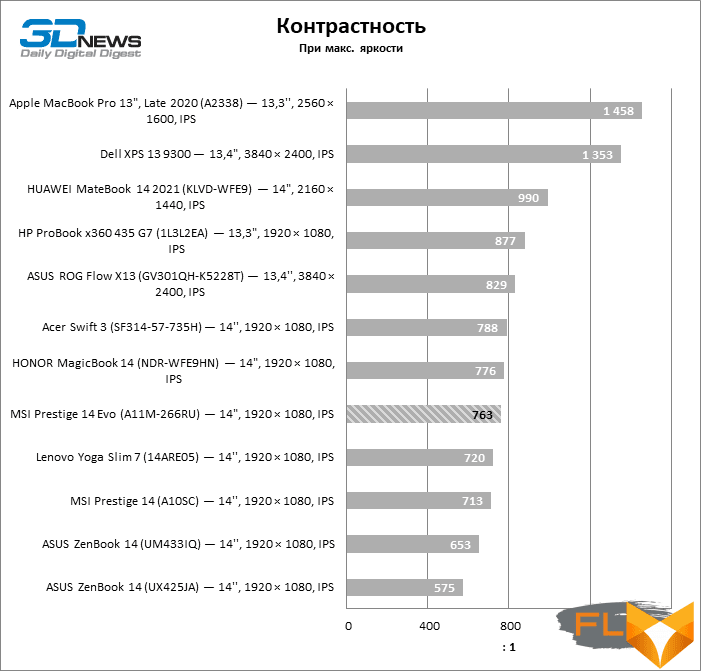
The green and red portions of the color range are outside the sRGB space, but the total area covered is 94%.
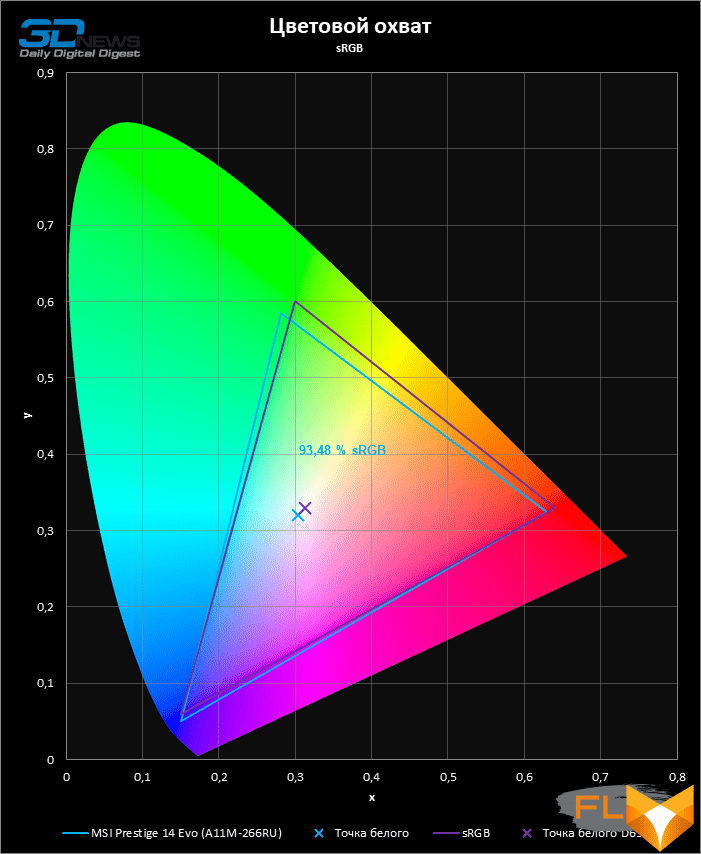
⇡#The color temperature is too high relative to the reference 6500 K.

The gamma correction curve repeats the shape specified by the sRGB standard, but over most of the gray scale gives a stronger contrast, which, although not up to standard, is more of a plus than a minus for content consumption.
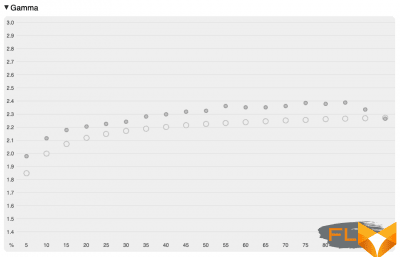 |
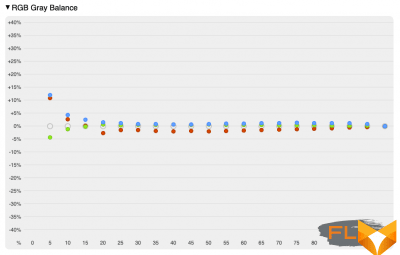 |
The individual base color curves do not converge perfectly, resulting in high Delta E values when reproducing some hues. But on average, the color accuracy is acceptable for a consumer-grade monitor – adjusted for a knocked down white point.
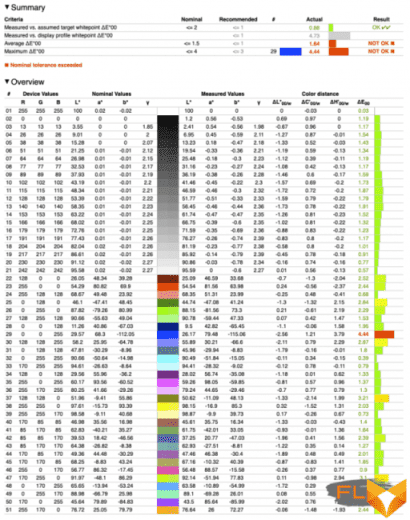
⇡#Clock speeds, temperature and noise levels
Intel has set the upper power consumption for the Core i7-1185G7 chip at 28W. The MSI Prestige 14 Evo processor can maintain this power consumption for a long time when all four x86 cores are fully loaded, when the balanced mode is activated in the laptop control software, and the clock speeds stabilize at a high level of 3.3 GHz. However, this is not the limit. The next, high-performance mode is a CPU overclock to almost 3.5 GHz, associated with an increase in power consumption up to 30 watts.
The integrated Intel Xe video core in both modes operates at a maximum rated frequency of 1.35 GHz. The GPU occupies a large share of the Tiger Lake die and, as a result, makes a significant contribution to power consumption. High-performance mode may not have much of an effect on performance when the load falls mainly on the CPU, but if graphics are also involved, changing the balanced mode to high-performance mode gives the x86 cores a good 500 MHz of clock speed.
| Load Clock | ||||||||
|---|---|---|---|---|---|---|---|---|
| Cinebench R20 (Max thread no.) | LuxMark 3.1 | Cinebench R20 (max thread no.) + LuxMark 3.1 | ||||||
| CPU clock speed, MHz | GPU clock speed, MHz | CPU clock speed, MHz | GPU clock speed, MHz | |||||
| Medium | Max | Medium | Max | Medium | Max | Medium | Max | |
| MSI Prestige 14 Evo (A11M-266RU) — Intel Core i7-1185G7 / Intel Iris Xe Graphics G7 — High Performance | 3465 | 3593 | 1346 | 1347 | 2914 | 2995 | 1309 | 1392 |
| MSI Prestige 14 Evo (A11M-266RU) — Intel Core i7-1185G7 / Intel Iris Xe Graphics G7 — Balanced | 3327 | 3394 | 1346 | 1347 | 2419 | 2496 | 1345 | 1348 |
| MSI Prestige 14 Evo (A11M-266RU) — Intel Core i7-1185G7 / Intel Iris Xe Graphics G7 — Silent | 2381 | 2395 | 1094 | 1098 | 1335 | 1398 | 757 | 846 |
| CPU and GPU power | ||||||||
|---|---|---|---|---|---|---|---|---|
| Cinebench R20 (Max thread no.) | LuxMark 3.1 | Cinebench R20 (max thread no.) + LuxMark 3.1 | ||||||
| CPU Wattage | GPU power consumption (SoC as a whole, if integrated), W | CPU Wattage | GPU power consumption (if discrete), W | |||||
| Medium | Max | Medium | Max | Medium | Max | Medium | Max | |
| MSI Prestige 14 Evo (A11M-266RU) – Intel Core i7-1185G7 / Intel Iris Xe Graphics G7 – High Performance | 30 | 31 | 22 | 24 | 36 | 36 | N/A | N/A |
| MSI Prestige 14 Evo (A11M-266RU) – Intel Core i7-1185G7 / Intel Iris Xe Graphics G7 – Balanced | 28 | 29 | 22 | 24 | 31 | 32 | N/A | N/A |
| MSI Prestige 14 Evo (A11M-266RU) – Intel Core i7-1185G7 / Intel Iris Xe Graphics G7 – Silent | 15 | 15 | 15 | 15 | 15 | 15 | N/A | N/A |
Note The measurement is performed after the device has warmed up and all parameters have stabilized.
With such a power SoC, it is not at all surprising that the temperature of the crystal under heavy load goes beyond 90 ° C, and the laptop is pretty noisy, especially in high-performance mode. The only way to combat heat and noise is to turn on quiet mode. Then the machine really becomes extremely quiet, and the crystal temperature does not exceed 80 ° C, but the clock speeds of the x86 cores have to be reset to 2.4 GHz, and with simultaneous load on the CPU and graphics, even to a very modest 1.3 GHz.
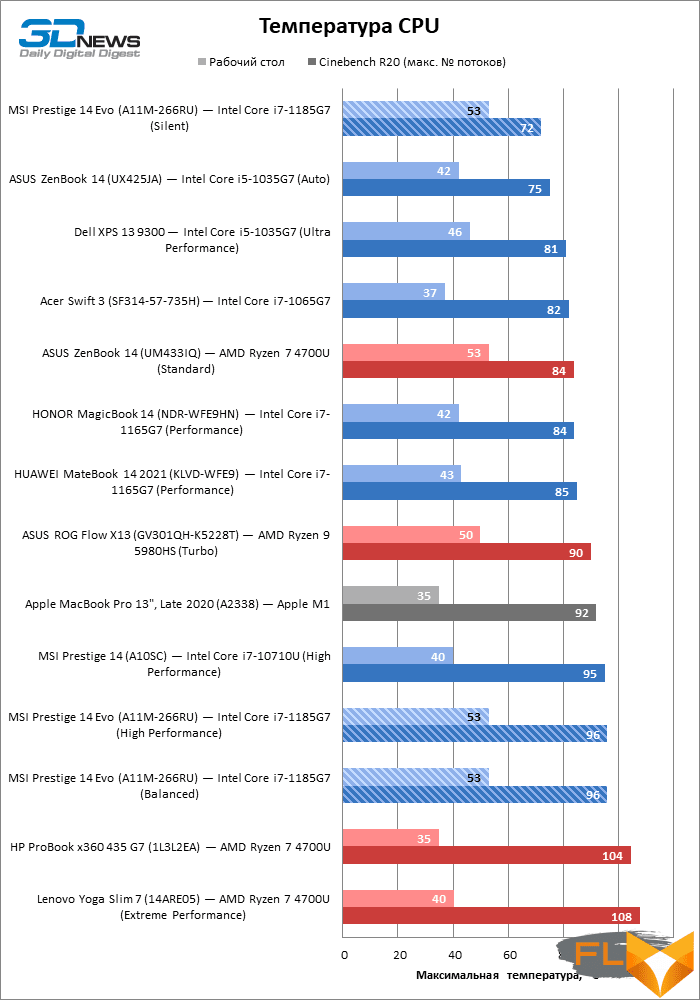
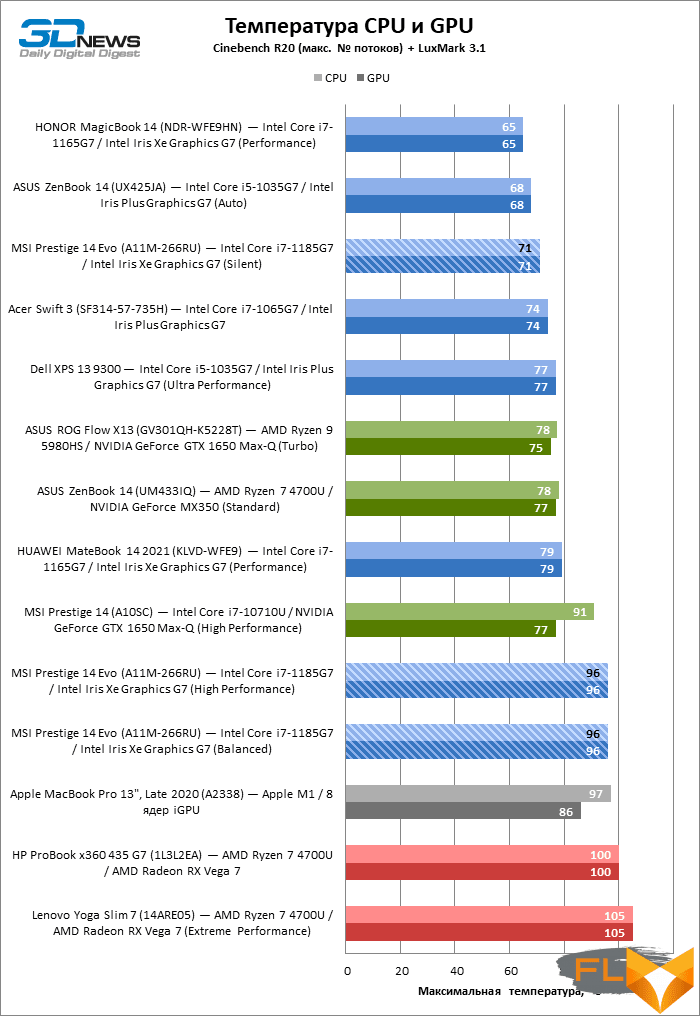
⇡#Synthetic Performance Tests
It would seem that the top model among low-wattage Intel processors based on the Tiger Lake core should lead at least among its own kind in any benchmarks. According to the cumulative results of Geekbench, it is. In the single-threaded test, all the older 11th generation chips scored only the Ryzen 5000-series processor, which has significantly more power reserve, can challenge it, and the increased clock speeds of the i7-1185G7 did not make a decisive difference. In multi-threaded competition, of course, eight-core CPUs are already leading, but the Core i7-1185G7 outperforms the next-old Tiger Lake model in terms of points along with not the best implementations of the AMD platform and is practically not inferior to the six-core Intel chip of the previous generation.
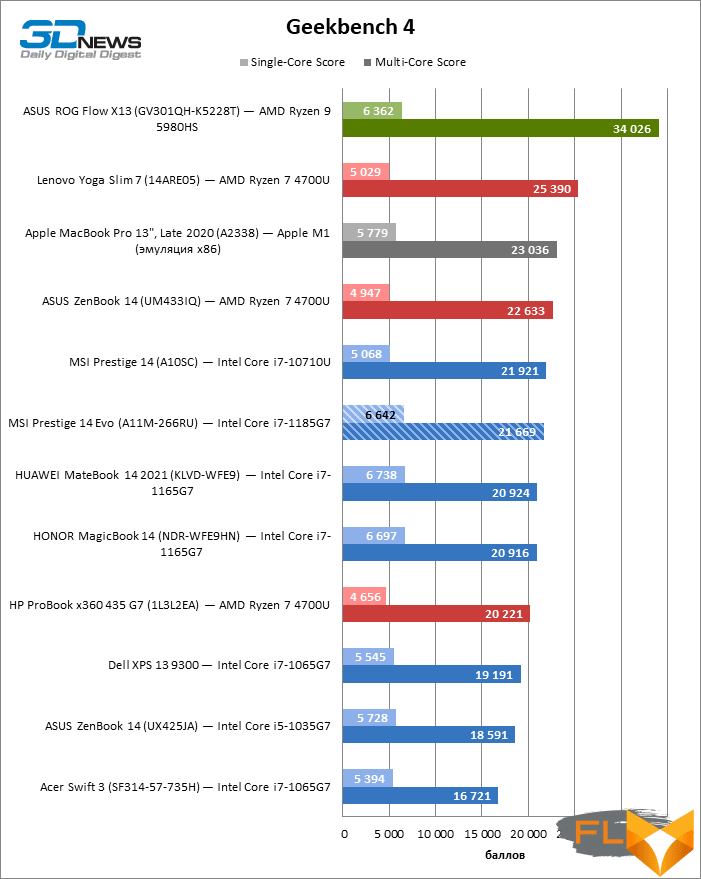
In the Cinebench test, everything turned out differently. The Core i7-1185G7 looks good against the background of energy-efficient quad-core Ice Lake chips and six-core Comet Lake chips, but among similar new-generation laptops, the Prestige 14 Evo was far from the first place. And the reason, most likely, is that MSI used LPDDR4X RAM, which is inferior to conventional DDR4 chips in terms of bandwidth.
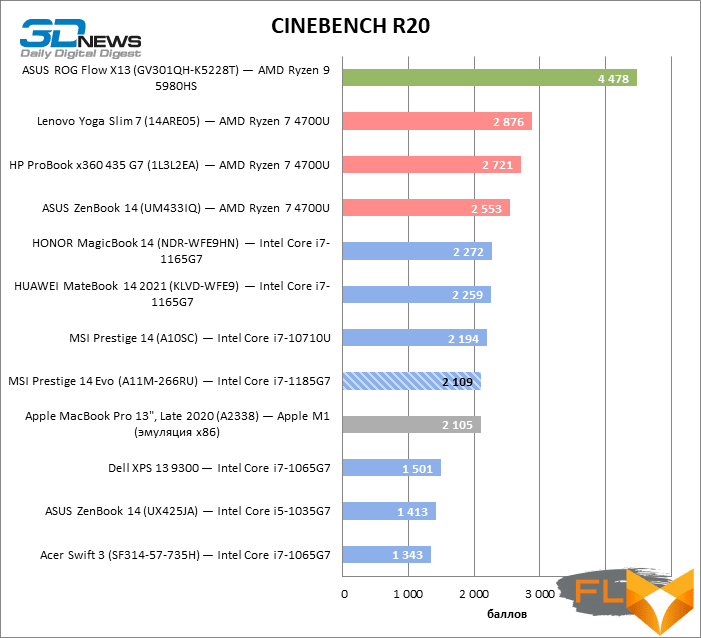
Apparently, in the full-screen tests of GFXBench, the frame rate on the integrated Intel Xe graphics turned out to be tied to the screen refresh rate (60 FPS) or half of it (30 FPS), but in terms of frame rate, independent of the current resolution of the laptop, the Prestige 14 Evo video adapter left far behind an integrated GPU of the less powerful Tiger Lake varieties along with entry-level discrete accelerators. The 3DMark results confirm this observation.
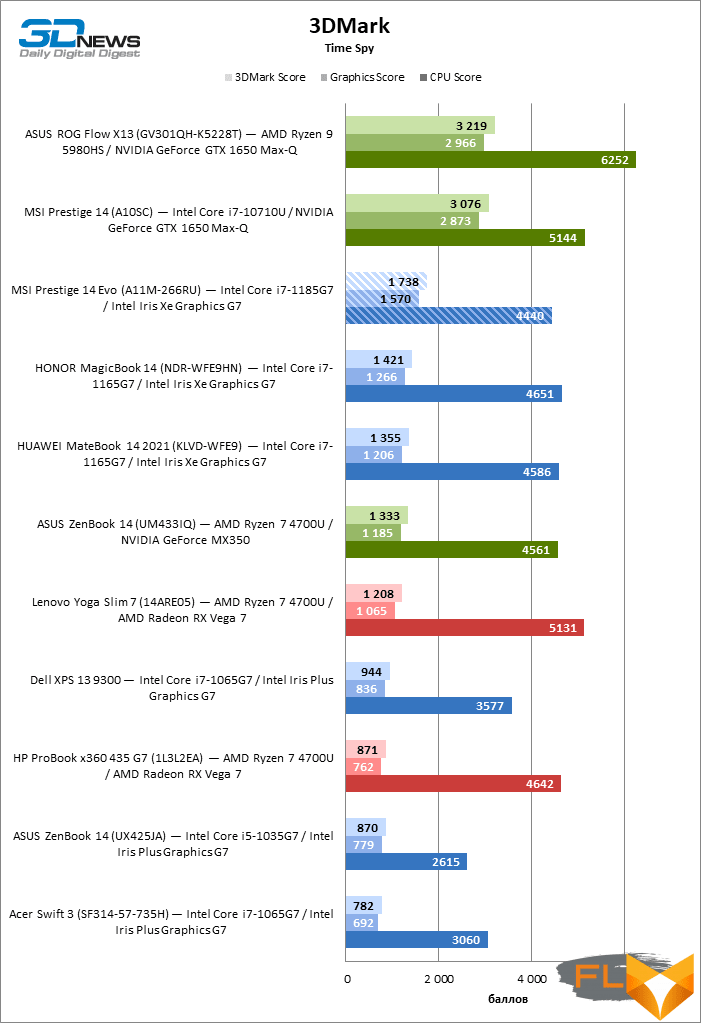
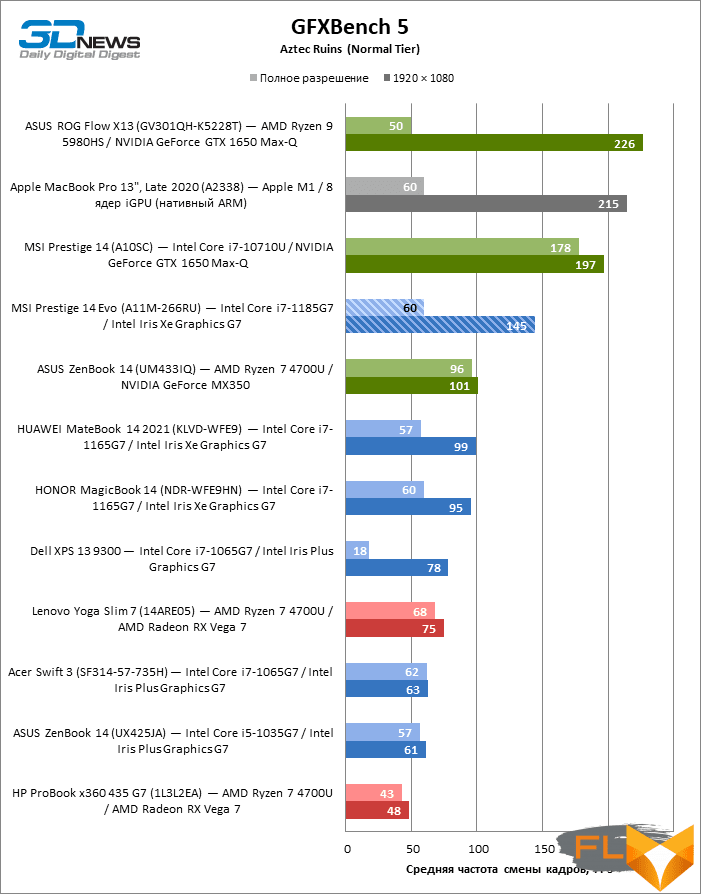
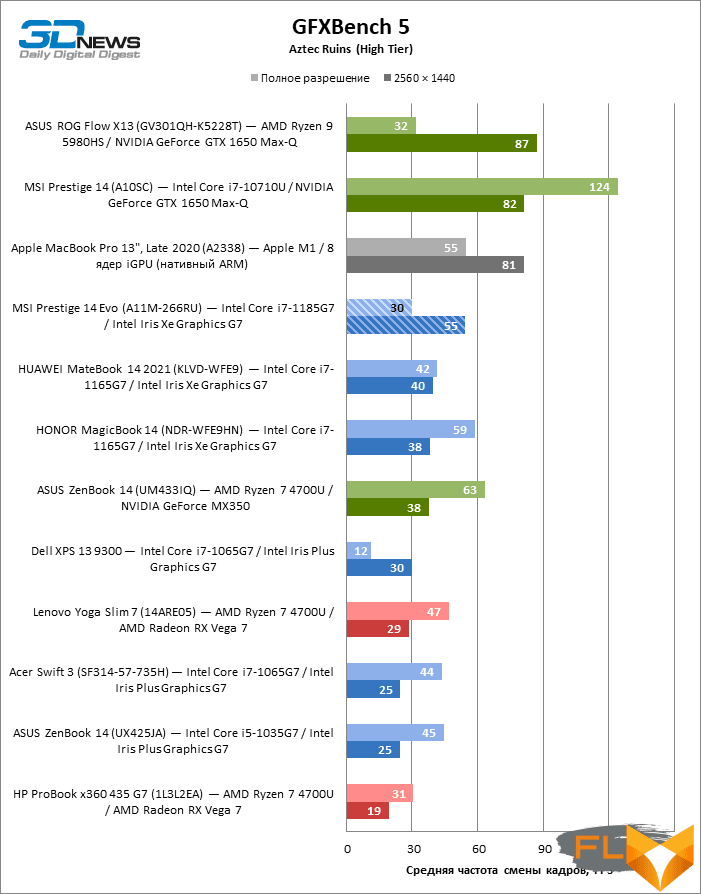
⇡#Performance in production applications
The software 3D rendering benchmark in Blender largely repeats the results of the synthetic Cinebench test. The top model among Intel’s energy-efficient 11th generation chips did not give the MSI Prestige 14 Evo any advantage over laptops equipped with the Core i7-1165G7, but this CPU is still no worse than the old six-core Intel processors and approaches the rendering speed to be limited by one or another reasons for implementations of AMD’s eight-core Ryzen platform.
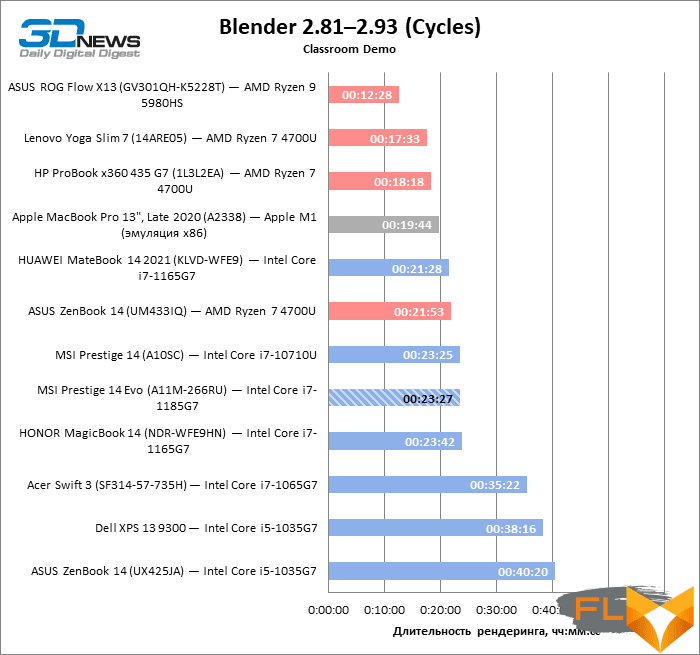
But in cases where a significant proportion of the computing load falls on Intel Xe graphics, MSI Prestige 14 Evo helps out with increased SoC power reserve. This accelerator performs better in game 3D rendering than in computational tasks, but factory overclocking has significantly reduced the gap with entry-level discrete GPUs.
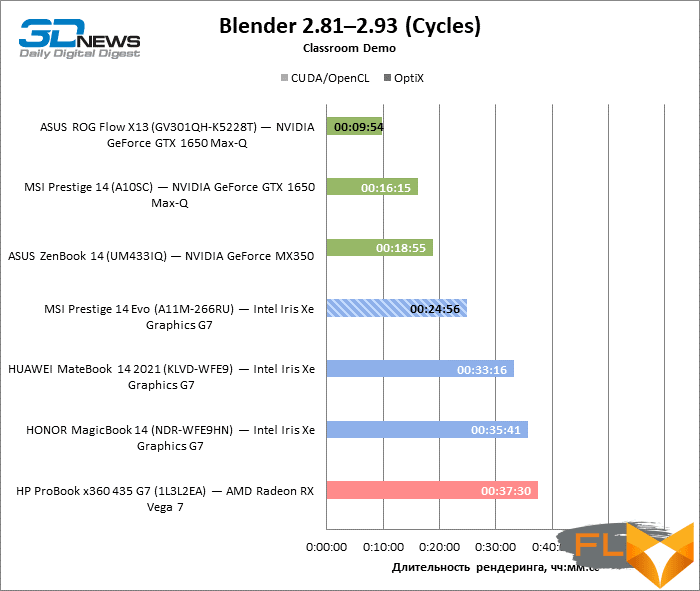
LPDDR4X RAM was no problem for the Prestige 14 Evo in the Lightroom benchmark. Here, the MSI product predictably leads the way, and only similar machines based on Tiger Lake chips and laptops with obviously more powerful eight-core AMD chips are suitable competitors for it.
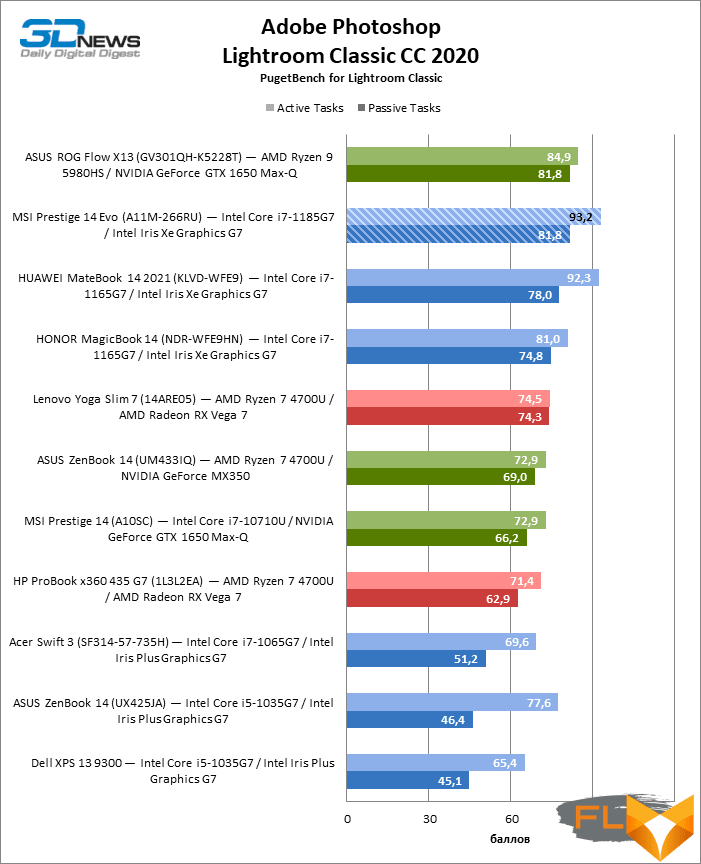
Note Scores are calculated as a percentage of Intel Reference Workstation performance Core i9-9900K, NVIDIA GeForce RTX 2080, 64GB RAM.
Photoshop doesn’t see much of a difference between the MSI Prestige 14 Evo and other laptops based on Intel’s 11th generation CPUs. In their energy class, these PCs offer unsurpassed performance.
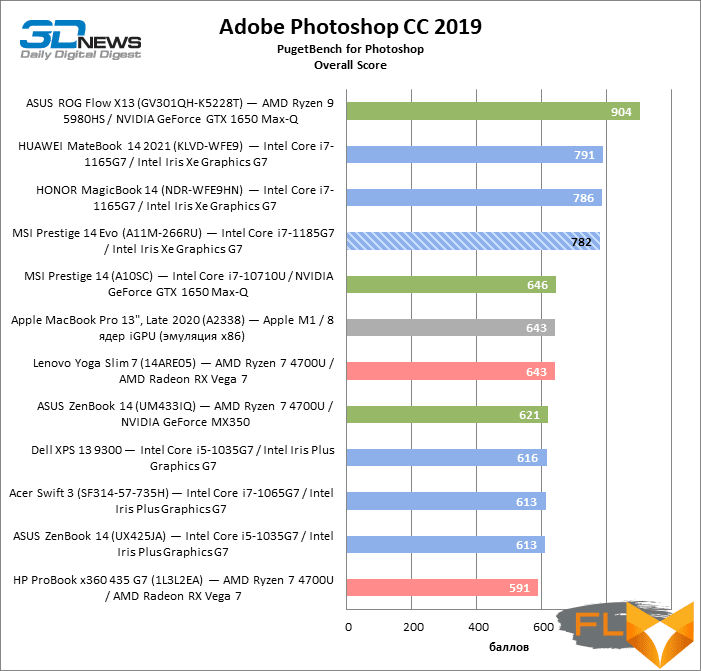
Note Scores are calculated as a percentage of Intel Reference Workstation performance Core i9-9900K, NVIDIA GeForce RTX 2080 and 64GB RAM x 10.
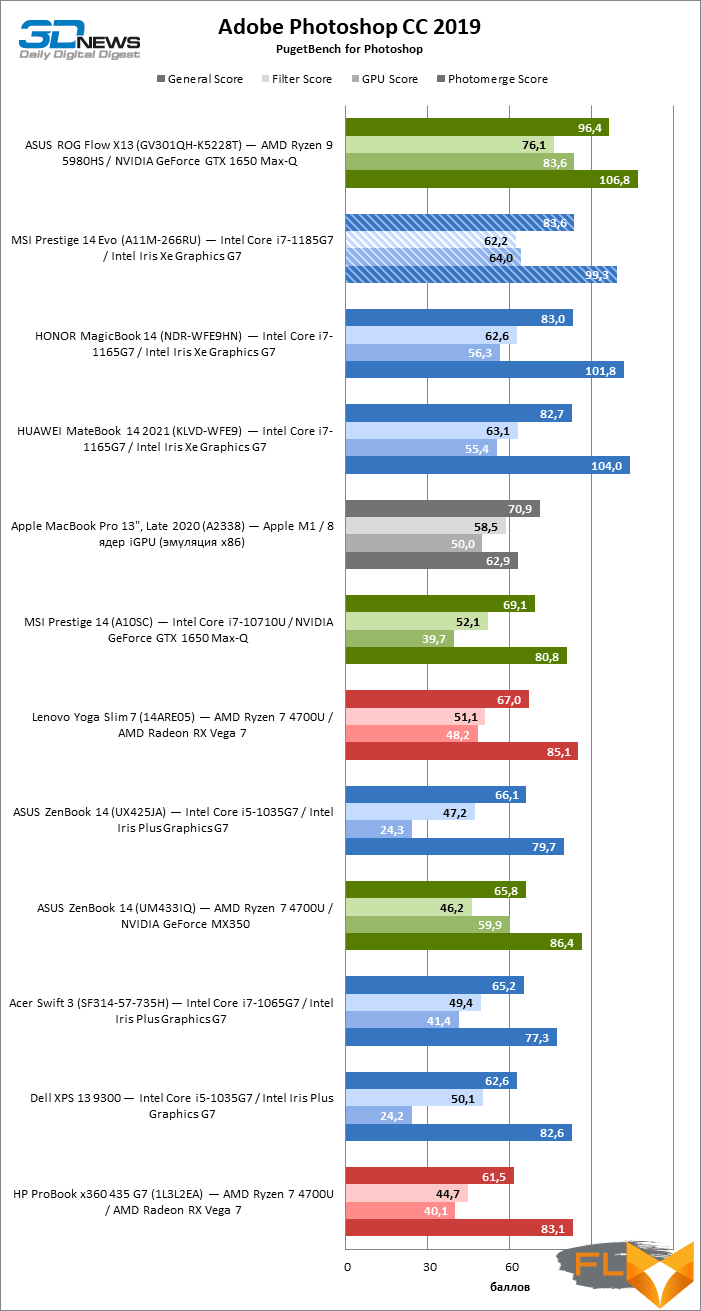
Note Scores are calculated as a percentage of Intel Reference Workstation performance Core i9-9900K, NVIDIA GeForce RTX 2080, 64GB RAM.
The features of the MSI laptop – high headroom of the CPU on the one hand, and LPDDR4X RAM on the other – led to mixed results in the Premiere Pro test suite. The Prestige 14 Evo is inferior to its counterparts in project frame rate and export speed when the main load falls on the CPU, although it still demonstrates good results at the level of laptops with a six-core 10th generation Intel CPU.
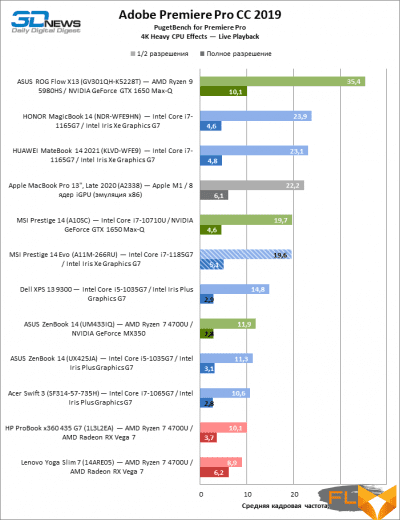 |
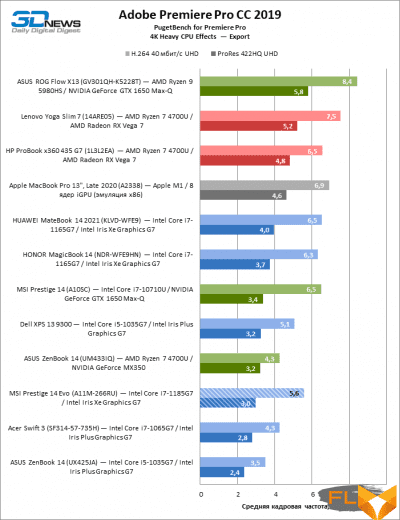 |
But if high performance of the CPU and graphics is required at the same time, then thanks to its power reserve, the MSI Prestige 14 Evo easily regains lost ground.
 |
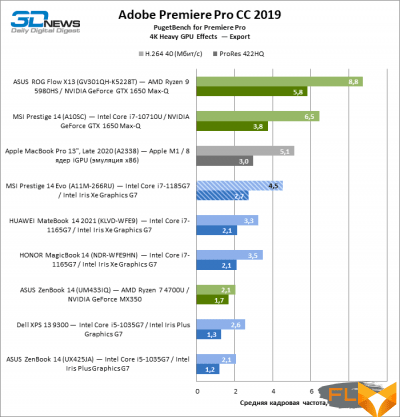 |
⇡# SSD Performance
MSI Prestige 14 Evo is the first ultrabook in our practice, which got a solid-state drive with a PCI Express 4.0 interface. And this is noticeable in the extremely high throughput in sequential read mode – up to 4.5 GB / s. Alas, the Phison drive achieves such indicators only in conditions of a long queue of commands, and with a short queue prevailing in desktop tasks, the advanced interface no longer provides any advantage. In terms of sequential write speed, this SSD is not inferior to the best solutions that are most often used in ultrabooks. We can’t complain about the random read speed either, but the Phison 1 TB SM2801T24GKBB4S-E162 random write performs rather slowly.
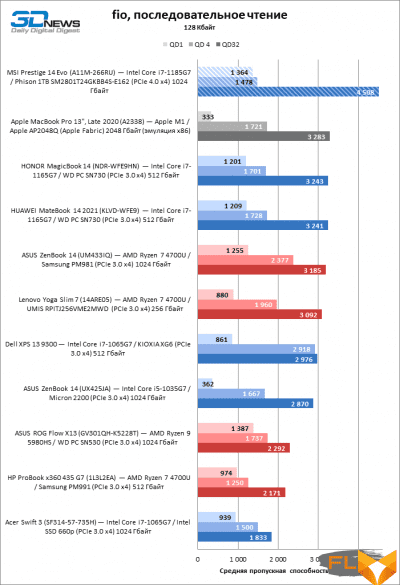 |
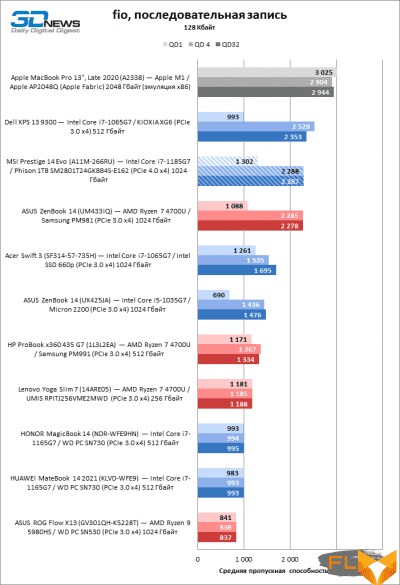 |
|
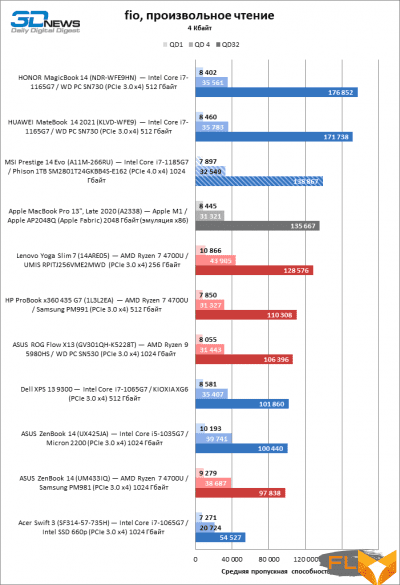 |
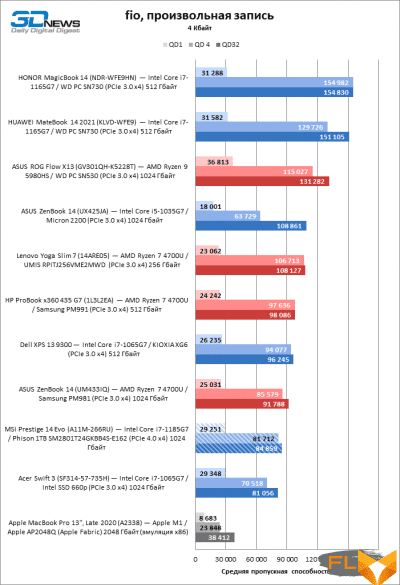 |
⇡# Battery life
Much in the MSI Prestige 14 Evo is conducive to a long battery life: both the energy efficiency of new generation Intel chips and the screen with a relatively low pixel density. But most importantly, this laptop can be put into maximum battery saving mode, which, of course, sacrifices performance, but as a result, autonomy increases up to a full 12 hours of video playback and 9 hours of continuous web surfing.
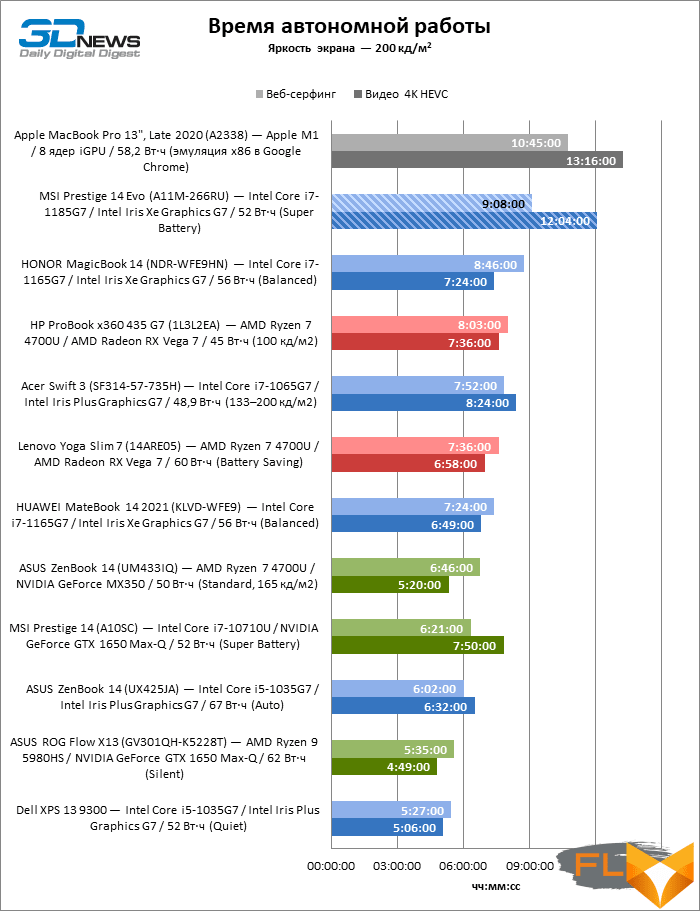
⇡#Conclusions
Intel’s new 11th generation CPUs don’t complain about performance, but if you want to get the most out of an ultrabook that hardware is capable of, MSI, as always, is happy to offer such an opportunity. The top processor in the economical Tiger Lake series (Core i7-1185G7) is a good start, but the Prestige 14 Evo also allows the chip to run at higher power, which is especially noticeable in situations where x86 cores are loaded simultaneously with demanding Intel Xe integrated graphics. The Prestige 14 Evo could have achieved better results, but in a number of tasks the processor is hindered by LPDDR4X RAM.
Add a PCI Express 4.0 SSD and two USB4 compatible Thunderbolt 4 ports and you have one of the strongest configurations in the new wave of ultrabooks without a discrete GPU. With flexible power settings, you can set your laptop to run as fast as you can to complete complex tasks faster, or, conversely, limit power in order to forget about charging for the whole day.
Perhaps the only thing you can complain about in the Prestige 14 Evo is the lack of body rigidity in those places where it is critical (keyboard and touchpad), and a high noise level under full load. Alas, otherwise it would not have been possible to make a machine with high-performance filling so light – or, conversely, squeeze such speed out of a compact business laptop.

